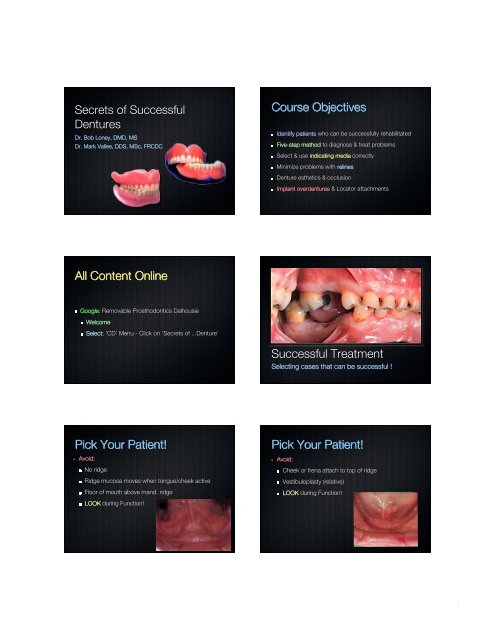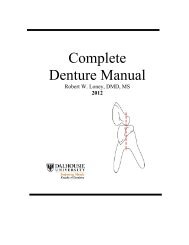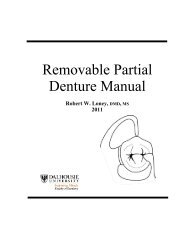Secrets of Successful Dent 1 - Removable Prosthodontics
Secrets of Successful Dent 1 - Removable Prosthodontics
Secrets of Successful Dent 1 - Removable Prosthodontics
Create successful ePaper yourself
Turn your PDF publications into a flip-book with our unique Google optimized e-Paper software.
<strong>Secrets</strong> <strong>of</strong> <strong>Successful</strong><br />
<strong>Dent</strong>ures<br />
Dr. Bob Loney, DMD, MS<br />
Dr. Mark Vallee, DDS, MSc, FRCDC<br />
Course Objectives<br />
Identify patients who can be successfully rehabilitated<br />
Five-step method to diagnose & treat problems<br />
Select & use indicating media correctly<br />
Minimize problems with relines<br />
<strong>Dent</strong>ure esthetics & occlusion<br />
Implant overdentures & Locator attachments<br />
All Content Online<br />
Google: : <strong>Removable</strong> <strong>Prosthodontics</strong> Dalhousie<br />
Welcome<br />
Select: ‘CD’ Menu - Click on ‘<strong>Secrets</strong> <strong>of</strong> ...<strong>Dent</strong>ure’<br />
<strong>Successful</strong> Treatment<br />
Selecting cases that can be successful !<br />
Pick Your Patient!<br />
• Avoid:<br />
No ridge<br />
Ridge mucosa moves when tongue/cheek active<br />
Floor <strong>of</strong> mouth above mand. ridge<br />
LOOK during Function!<br />
Pick Your Patient!<br />
• Avoid:<br />
Cheek or frena attach to top <strong>of</strong> ridge<br />
Vestibuloplasty (relative)<br />
LOOK during Function!<br />
1
Pick Your Patient!<br />
Pick Your Patient!<br />
• Caution:<br />
No saliva<br />
Poor nutrition<br />
Many sets in several years<br />
•Spend time Talking<br />
• Caution:<br />
Severe wear, loss OVD<br />
Severe undercuts/tori &<br />
don’t t want surgery<br />
Pick Your Patient!<br />
• Caution:<br />
No dentures for many years<br />
Patient who doesn’t want dentures<br />
Patient who doesn’t need dentures<br />
When Not to Treat Partially<br />
<strong>Dent</strong>ate!<br />
Patient doesn’t t want treatment<br />
Comfortable<br />
Happy with appearance<br />
Function not a problem<br />
Inform <strong>of</strong> consequences, costs, options<br />
Don’t t talk patient into treatment<br />
Shortened <strong>Dent</strong>al Arch (SDA)<br />
Treatment Option: No Replacement<br />
Shortened <strong>Dent</strong>al Arch (SDA)<br />
No Replacement<br />
Shortened <strong>Dent</strong>al Arch (SDA)<br />
Patients can function with<br />
as few as 20 occluding<br />
teeth<br />
No significant difference in<br />
chewing<br />
discomfort<br />
JCDA Sept 07, 73:593-4<br />
Require Anterior teeth + 4-6<br />
occlusal units<br />
Opposing PM’s = 1 occlusal unit<br />
Opposing M’s = 2 occlusal units<br />
Symmetric loss need 4 units<br />
Assymetric loss need 6 units<br />
2
Patient Satisfaction<br />
Patient Satisfaction<br />
More than good anatomy<br />
More than well constructed denture<br />
Includes expectations<br />
• Difficult to quantify, unpredictable<br />
• Not directly correlated with quality<br />
• Small percentage never satisfied<br />
• Low quality results in lower satisfaction<br />
• Patients more satisfied with dentures<br />
than eyeglasses and hearing aids<br />
Satisfaction With various<br />
prosthesis<br />
Patient Characteristics<br />
Percentage <strong>of</strong> patients satisfied with prosthesis<br />
•Not correlated with satisfaction:<br />
• Personality<br />
• Age<br />
• Attitude toward aging<br />
•Reduced salivary flow & reduced ridge<br />
negatively correlated<br />
Smedley TC, Friedrichsen SW, Cho MH: A comparison <strong>of</strong> self-assessed satisfaction among wearers <strong>of</strong> dentures, hearing aids, and eyeglasses. J Prosthet <strong>Dent</strong>. 1989; 62: 654-661.<br />
Fabrication Variables<br />
Patient Expectations<br />
• Related to satisfaction:<br />
• clinical remounts<br />
• accurate impressions & occlusal records<br />
• patient involvement in denture esthetics<br />
• High expectations if currently<br />
dissatisfied<br />
• Unrealistic expectations negatively<br />
correlate with satisfaction<br />
• Pre-treatment interview can help<br />
determine expectations<br />
3
Matching Expectations<br />
Iatrosedative Interview<br />
• Critical for success<br />
• If patient & dentist don’t expect the<br />
same result - failure<br />
• Helps determine need for referral<br />
• 1. Recognize & acknowledge problem<br />
• 2. Explore & identify problem<br />
• 3. Interpret & explain problem<br />
• 4. Offer a solution<br />
Iatrosedative Interview<br />
Iatrosedative Interview<br />
• 1. Recognize & acknowledge problem<br />
•Patient: “My problem is .... I’d like.... They’re<br />
too...”<br />
•<strong>Dent</strong>ist: “So your dentures feel..., I can see they<br />
are... That must be difficult ...”<br />
• 2. Explore & identify problem<br />
•<strong>Dent</strong>ist:<br />
•History - “You say the dentures loosen only<br />
when you are chewing on the left side?”<br />
•Exam - Visual intraoral check. Look for<br />
variations from normal in denture & tissue. Use<br />
indicating media. Have patient demonstrate the<br />
problem. Palpate.<br />
Iatrosedative Interview<br />
• 3. Interpret & explain problem<br />
•“It appears that the denture teeth may be too far<br />
away from your bone. There is not much bone to<br />
support them. Look here in the mirror... “<br />
•“The denture will always be looser than normal<br />
unless...”<br />
Iatrosedative Interview<br />
• 4. Offer a solution<br />
• <strong>Dent</strong>ist:<br />
• “So to review, you have 3 things you want changed..<br />
• You don’t want these 2 things changed...<br />
• I can change/improve ... but not....because...<br />
• Do you understand...Do you have any questions<br />
• What would you like to do? “<br />
4
Conclusions<br />
• Small percentage never satisfied,<br />
even with highest quality<br />
• Comprehensive interview can help<br />
identify patients with high expectations<br />
• Low clinical quality related to reduced<br />
patient satisfaction<br />
5 Step <strong>Dent</strong>ure<br />
Troubleshooting<br />
1. Differential Diagnosis<br />
2. Look for Normal<br />
3. Patient Demonstrates Problem<br />
4. Never Adjust without Indicating Media **<br />
5. Patient Rates Improvement<br />
Principal 1<br />
Establish a Differential Diagnosis<br />
• Form a list <strong>of</strong> possible causes<br />
• Try to prove problem is not caused by<br />
“X” by eliminating possible causes<br />
• Expect resolution within 10-14 days<br />
• If no resolution, eliminate something<br />
else<br />
Principle 1: Differential Diagnosis<br />
• Prioritize from common to rare<br />
• Eliminate common etiologies first,<br />
because:<br />
Common things<br />
occur commonly<br />
Rare entities occur<br />
rarely<br />
Differential Diagnosis:<br />
CD or RPD Pain<br />
Principles <strong>of</strong> Diagnosis<br />
Occlusion<br />
Remount, Articulating<br />
Paper, Adjust<br />
<strong>Dent</strong>ure Base<br />
PIP, Adjust<br />
Vertical Dimension<br />
Infection<br />
Systemic Disease<br />
Allergy<br />
Time to Adapt,<br />
Reset Teeth<br />
Tests, Referrals,<br />
Medications<br />
Patch Tests, Referrals,<br />
Change Materials<br />
Attempt to<br />
eliminate<br />
problem.<br />
Re-evaluate<br />
results in<br />
10-14 days<br />
• Don’t t limit list too early in diagnosis<br />
• Keep an open mind<br />
• Revisit possible causes<br />
5
Information Gathering<br />
Gathering Information<br />
• Chief Complaint<br />
– History <strong>of</strong> C.C.<br />
• History<br />
– Medical<br />
– <strong>Dent</strong>al<br />
• Clinical Exam<br />
Often inadequately<br />
investigated<br />
Spend more time<br />
talking to narrow<br />
possibilities<br />
•Ask open ended questions:<br />
•“How does that feel?”<br />
•Not<br />
•“Does that feel better?”<br />
History <strong>of</strong> Chief Complaint<br />
Where?<br />
History <strong>of</strong> Chief Complaint<br />
When?<br />
• Have patient point to problem<br />
• Partially ignore patient’s<br />
position<br />
• <strong>Dent</strong>ist locate with stick,<br />
instrument or paste<br />
• Chewing only - Occlusion<br />
• Gets worse throughout day<br />
- Occlusion<br />
• When first insert dentures -<br />
<strong>Dent</strong>ure Base<br />
History <strong>of</strong> Chief Complaint<br />
Details<br />
Principle 2:<br />
Identify Variations from Normal:<br />
Tissues & <strong>Dent</strong>ures<br />
• How long?<br />
• ...does it last?<br />
• ...since it began?<br />
• Anything make it better/worse?<br />
6
Identify Variations from Normal<br />
Loose <strong>Dent</strong>ure:<br />
Prominent Midline Fissure, S<strong>of</strong>t<br />
Palate<br />
Dealing with Variations From Normal<br />
If denture alone is not normal<br />
correct the denture<br />
If anatomy/patient not normal<br />
vary method to address variation<br />
Principle 3:<br />
Patient Demonstrates Problem<br />
Eliminate cause - resolve in 10-14 days<br />
Principle 4:<br />
Always Use Indicating Media<br />
Principle 5:<br />
Rate Improvement<br />
100% Perfect Now<br />
75% Feels a lot better<br />
•Never adjust without locating<br />
exact position <strong>of</strong> the problem<br />
•Use paste, indelible stick, or<br />
articulating paper<br />
•After adjustment<br />
•Ask patient to rate<br />
improvement<br />
•0%-100%<br />
50% Better, but still not right<br />
0% Still Same, Can’t Tell<br />
7
5 Step <strong>Dent</strong>ure<br />
Troubleshooting<br />
Use <strong>of</strong> Indicating Media<br />
Loney & Knechtel,J Prosthet <strong>Dent</strong> 2009;101:137-141<br />
1. Differential Diagnosis<br />
2. Look for Normal<br />
3. Patient Demonstrates Problem<br />
4. Never Adjust without Indicating Media **<br />
5. Patient Rates Improvement<br />
Applying Pressure Indicating Paste<br />
More the colour <strong>of</strong> indicating medium<br />
than denture<br />
Dry denture<br />
Thin coat with stiff brush<br />
Leave streaks<br />
Correct Amount<br />
with Streaks<br />
Insufficient<br />
Amount<br />
Too Much<br />
w/o Streaks<br />
Prior to Placement<br />
Seat <strong>Dent</strong>ure Firmly<br />
Ensure damp mucosa<br />
Spray surface <strong>of</strong> PIP with air/water<br />
Avoid lips/ridge when<br />
inserting<br />
Pressure over first molars<br />
(not palate)<br />
Remove from oral cavity by<br />
breaking seal - finger<br />
pushing height <strong>of</strong> vestibule<br />
8
Reading PIP<br />
Burn-through (No paste left)<br />
- Excessive pressure that should be relieved<br />
Streaks remaining<br />
- No tissue contact<br />
- Other areas need to be relieved<br />
Paste remaining with no streaks<br />
- Acceptable contact<br />
Read the Paste<br />
Burn through<br />
Normal Contact<br />
No Contact<br />
Non-retentive <strong>Dent</strong>ure<br />
What’s s Wrong?<br />
<strong>Dent</strong>ure Base Adjustment<br />
Relieve pressure spots - large acrylic burs<br />
• No palatal<br />
contact<br />
• Short Flange in<br />
1st quad<br />
Take care with undercuts<br />
Looks like burn-through<br />
May not require adjustment<br />
Use Care in Retentive Areas<br />
Watch for Bony Impingements<br />
Hamular Notch<br />
Tuberosity Undercuts<br />
Relieve<br />
9
Check for Retention<br />
Pull outward & upward on lingual <strong>of</strong> canines<br />
Repeat Until <strong>Dent</strong>ure Fully Seats<br />
Relatively uniform contact<br />
Minimal streaks<br />
No gross burn-through<br />
Visually Check Peripheries<br />
Seat denture & border mold<br />
Flanges should fill vestibule<br />
but not be dislodged by<br />
manipulation<br />
If denture dislodges, use<br />
PIP to adjust<br />
Peripheries<br />
Border mold<br />
Adjust<br />
Check again<br />
Adjust high spots or facets<br />
Special Attention to Frenal Areas<br />
Special Attention to Frenal Areas<br />
10
Use to Check Contours<br />
Alter Phonetics<br />
Root prominences<br />
Thick peripheries<br />
More Info see: Website ‘Resources’<br />
Paste Removal<br />
Gauze, cotton rolls, toothbrushes<br />
Alcohol for stubborn areas<br />
Cheap steamer<br />
Cement, debris<br />
<strong>Secrets</strong> <strong>of</strong> Impressions<br />
• Polyvinyl Siloxanes<br />
Dimensional Stability<br />
Detail<br />
Use for all procedures<br />
<strong>Secrets</strong> <strong>of</strong> Impressions<br />
Final Impressions<br />
Load quickly - viscosity<br />
Material brought over periphery<br />
• Everything Dry<br />
11
<strong>Secrets</strong> <strong>of</strong><br />
Impressions<br />
Two Mirror Technique<br />
- everything visible<br />
<strong>Secrets</strong> <strong>of</strong> Impressions<br />
Seat anterior <strong>of</strong> tray<br />
first<br />
Cotton swabs on<br />
tray - remove<br />
excess posterior<br />
<strong>Secrets</strong> <strong>of</strong> Impressions<br />
<strong>Secrets</strong> <strong>of</strong> Impressions<br />
Flange thickness<br />
Tray not overextended<br />
<strong>Secrets</strong> <strong>of</strong> Impressions<br />
Why remake?<br />
Relines<br />
This denture needs a reline!<br />
12
Materials<br />
Tissue Conditioners<br />
PVS Light Body<br />
Self/Light Cure?<br />
undercuts<br />
distortion<br />
porosity<br />
Clean the <strong>Dent</strong>ure<br />
Inspect when dry!<br />
Position the <strong>Dent</strong>ure<br />
OVD & Occlusion<br />
Improperly Placed!<br />
Longer Teeth!<br />
Lousy Occlusion!<br />
Relieve <strong>Dent</strong>ure<br />
Relieve <strong>Dent</strong>ure<br />
Remove undercuts<br />
Shorten flanges<br />
Create space for<br />
material<br />
Vent holes for relief <strong>of</strong><br />
hydraulic pressure<br />
13
Remove Excess Material<br />
Mark Contacts Prior to/After Reline<br />
Cotton Swabs on tray<br />
Better Contours<br />
Red/Blue<br />
Should be close<br />
If not, don’t t proceed<br />
Posterior Palatal Seal<br />
Needed for retention<br />
<strong>Secrets</strong> <strong>of</strong> Jaw Relation Records<br />
Record Bases stable & retentive<br />
Perfectly flat contact between rims<br />
<strong>Secrets</strong> <strong>of</strong> Jaw Relation Records<br />
<strong>Secrets</strong> <strong>of</strong> Jaw Relation Records<br />
Ensure:<br />
Record bases don’t t contact<br />
anything<br />
Casts don’t t contact anything<br />
Only wax rim to wax rim<br />
contact<br />
Wax Rim Adjustment Video<br />
14
<strong>Secrets</strong> <strong>of</strong> Jaw Relation Records<br />
Centric Record with PVS<br />
Consider polyvinyl siloxane<br />
records<br />
Aluwax the most variable<br />
Elastomers least errors<br />
Video Clip<br />
• Mullick et al. J Prosthet <strong>Dent</strong> 1981;46:304<br />
• Ockert-Eriksson et al, Int J Prosthodont 2000<br />
• Millstein & Hsu, J Prosthet <strong>Dent</strong> 1994<br />
• Breeding et al, J Prosthet <strong>Dent</strong> 1994<br />
Partially <strong>Dent</strong>ate Casts<br />
<strong>Secrets</strong> <strong>of</strong> Jaw Relation Records<br />
If stable contacts (no rocking)<br />
Most accurate mounting - no medium<br />
Elastomers are extremely<br />
accurate<br />
Remove occlusal blebs from<br />
dentate casts<br />
Won’t t fit into interproximals<br />
on some casts<br />
If cast doesn’t t fit into record,<br />
may need to adjust<br />
<strong>Secrets</strong> <strong>of</strong> Jaw Relation Records<br />
Stabilize casts when<br />
mounting<br />
Mean occlusal discrepancy <strong>of</strong><br />
1.6mm when hand held<br />
0.25 mm sticks & sticky wax<br />
<strong>Secrets</strong> <strong>of</strong> <strong>Dent</strong>ure<br />
Occlusion<br />
All posteriors contact simultaneously<br />
•<br />
• (Gunderson & Siegel, J Prosthodont 2002)<br />
15
<strong>Secrets</strong> <strong>of</strong> <strong>Dent</strong>ure<br />
Occlusion<br />
<strong>Secrets</strong> <strong>of</strong> <strong>Dent</strong>ure Occlusion<br />
No contacts on inclines<br />
• Contacts buccal to the ridge<br />
destabilize - even monoplane<br />
• Browning, JPD 1986<br />
<strong>Removable</strong> partial<br />
dentures<br />
B caused unseating<br />
B<br />
C<br />
M<br />
L<br />
Central loading better than<br />
distal loading<br />
D<br />
<strong>Secrets</strong> <strong>of</strong> <strong>Dent</strong>ure<br />
Occlusion<br />
Excessive overbite will destabilize<br />
<strong>Secrets</strong> <strong>of</strong> <strong>Dent</strong>ure<br />
Occlusion<br />
Light rapid taps sound loud, mark widely<br />
Video Clip<br />
<strong>Secrets</strong> <strong>of</strong> <strong>Dent</strong>ure<br />
Occlusion<br />
No best occlusal scheme - use easiest possible<br />
monoplane, lingualized, fully balanced<br />
<strong>Secrets</strong> <strong>of</strong> <strong>Dent</strong>ure Contours<br />
No sharp contours<br />
Mildly convex lingual and buccal contours<br />
Use finger to feel for sharp contours<br />
16
<strong>Secrets</strong> <strong>of</strong> <strong>Dent</strong>ure Delivery<br />
• Step 1<br />
• Check <strong>Dent</strong>ure base with PIP<br />
• Moisten with air water syringe<br />
• No peripheries<br />
<strong>Secrets</strong> <strong>of</strong> <strong>Dent</strong>ure Delivery<br />
• Step 2<br />
• <strong>Dent</strong>ure peripheries with PIP<br />
• One side at a time<br />
•Avoid cheeks<br />
<strong>Secrets</strong> <strong>of</strong> <strong>Dent</strong>ure Delivery<br />
• Step 3<br />
• Occlusal Adjustment<br />
• Remount with help<br />
Laboratory Prescription<br />
Fabricate:<br />
Remount index<br />
Remount casts<br />
Remount maxillary denture<br />
Record Centric Relation<br />
<strong>Secrets</strong> <strong>of</strong> <strong>Dent</strong>ure Delivery<br />
• Step 3<br />
• Remount with help<br />
Small amount <strong>of</strong> bite<br />
registration material<br />
Just cuspal indentations<br />
• Assistant remounts denture using centric record<br />
• Stabilize casts<br />
17
Adjust Occlusion<br />
Extraoral adjustment more<br />
efficient<br />
Eliminates continual removal &<br />
replacement <strong>of</strong> dentures<br />
Avoids reflex avoidance<br />
<strong>Secrets</strong> <strong>of</strong> <strong>Dent</strong>ure Delivery<br />
• Step 4<br />
• Chewing Test<br />
• Cotton roll<br />
• No discomfort<br />
• If discomfort now, worse after use<br />
<strong>Secrets</strong> <strong>of</strong> <strong>Dent</strong>ure Delivery<br />
• Step 5<br />
• Check Esthetics & Phonetics<br />
• If large change, warn a head <strong>of</strong> time<br />
<strong>Secrets</strong> <strong>of</strong> <strong>Dent</strong>ure Delivery<br />
• Step 6<br />
• Polish<br />
• Brasseler <strong>Dent</strong>ure Polishers<br />
6 Step Delivery<br />
Step 1 Adjust <strong>Dent</strong>ure base with PIP<br />
Step 2 <strong>Dent</strong>ure peripheries with PIP<br />
Step 3 Occlusal Adjustment<br />
Step 4 Chewing Test<br />
Step 5 Check Esthetics & Phonetics<br />
Step 6 Polish<br />
18















